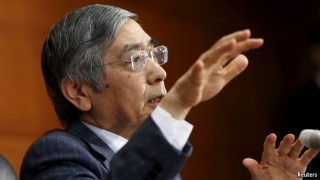Loading
Search
▼ Japan Adjusts Its Quantitative-easing Programme
- Category:Other

ECONOMIST
THE Bank of Japan’s move to tweak its programme of quantitative easing (QE) on Friday came from left field. Financial markets had largely given up on any further action this year from the bank’s governor, Haruhiko Kuroda, and were in any case entirely focused on the rate rise by America’s Federal Reserve on December 16th.
What came out of Japan was hardly as dramatic. The BoJ began its QE—printing money to buy bonds—in April 2013, and in October 2014 it expanded the programme to ¥80 trillion a year ($660 billion at the current exchange rate), up from between ¥60 trillion and ¥70 trillion a year. This time it left the pace of its annual asset purchases unchanged. But it did make four minor adjustments, largely to facilitate and fine-tune what it was doing already.
The first was to lengthen the maturity of the Japanese government bonds (JGBs) that it is buying, from 7-10 years to 7-12 years, in order to “encourage a smoother decline in interest rates across the entire yield curve”. That should help bring down yields on longer-term bonds, which at over 1% are still relatively high.
A second step added a little firepower and an intriguing qualitative twist. The bank will add an extra ¥300 billion to its existing scheme of buying exchange-traded funds (ETFs). Since the current programme is worth ¥3 trillion a year, the effect will not be great. But the BoJ also said it would put its fresh cash into ETFs that focus on domestic firms “proactively making investment in physical and human capital”.
That marks a new step by the BoJ to further the structural-reform agenda of Abenomics, the programme of Shinzo Abe, the prime minister, that aims at pepping up economic growth. Mr Abe’s government is exerting strong pressure on firms to invest more, rather than continue to sit on huge cash hoards. The BoJ’s move therefore underlines policy co-ordination by the government and the central bank.
Then came two technical changes. To guard against the effects of any shortage of JGBs in the market caused by the central bank’s hoovering-up of bonds, it will now accept foreign-currency-denominated loans on deeds and housing-loans portfolios as collateral. It has also marginally loosened the restrictions on its purchases of real-estate investment trusts, while keeping the total sum unaltered.
All of this, as Mr Kuroda made clear in a press conference after his policy meeting, stopped well short of an expansion of monetary easing. He offered no clue to what BoJ-watchers immediately wanted to know—whether these tweaks affect the likelihood that the bank will pull out its bazooka for a third time in 2016. Many reckon that more easing is inevitable, since headline inflation is still far below the bank’s target of 2%, and consumption and growth remain fragile.
The central bank will want to see the currency impact of the Fed’s rate rise, which could help to weaken the yen. And at least the recent news that GDP grew by an annualised 1% in the third quarter of 2015, rather than contracting as initial estimates had shown, gave some grounds for cautious optimism on the economy. The BoJ’s policy statement today noted that exports are at last picking up, as well as acknowledging that “some indicators have recently shown relatively weak developments”.
The BoJ’s fine-tuning is also a welcome reminder that the original three “arrows” of Abenomics—monetary, fiscal and structural—remain at the heart of government policy.
- January 8, 2016
- Comment (0)
- Trackback(0)

